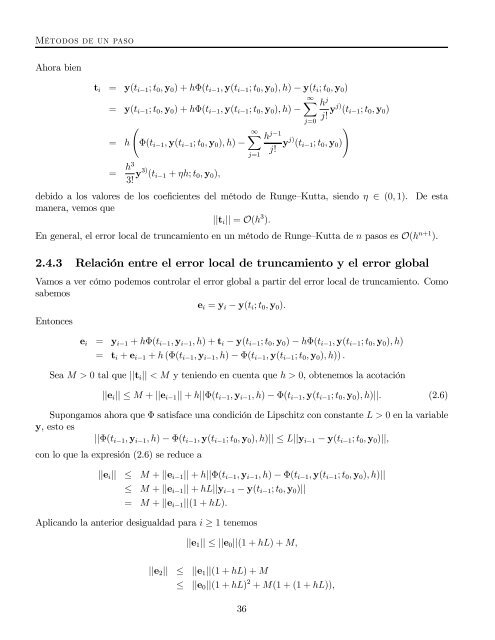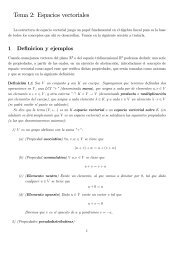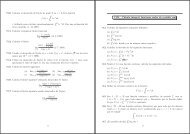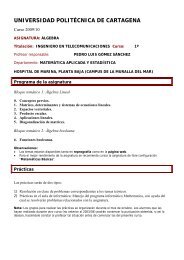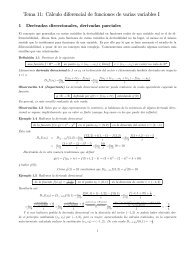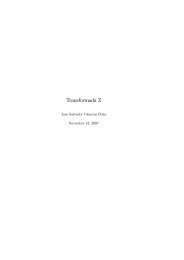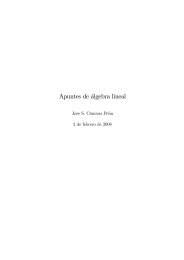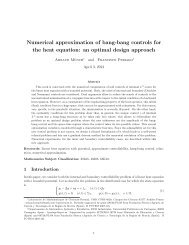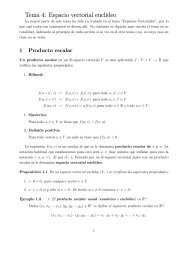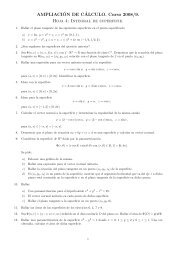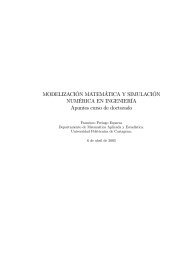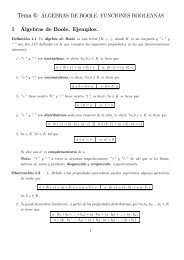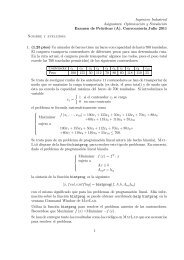Métodos numericos: ecuaciones diferenciales ordinarias
Métodos numericos: ecuaciones diferenciales ordinarias
Métodos numericos: ecuaciones diferenciales ordinarias
You also want an ePaper? Increase the reach of your titles
YUMPU automatically turns print PDFs into web optimized ePapers that Google loves.
<strong>Métodos</strong>deunpaso<br />
Ahora bien<br />
ti = y(ti−1; t0, y0)+hΦ(ti−1, y(ti−1; t0, y0),h) − y(ti; t0, y0)<br />
=<br />
∞X h<br />
y(ti−1; t0, y0)+hΦ(ti−1, y(ti−1; t0, y0),h) −<br />
j=0<br />
j<br />
j! yj) =<br />
(ti−1; t0, y0)<br />
Ã<br />
∞X h<br />
h Φ(ti−1, y(ti−1; t0, y0),h) −<br />
j−1<br />
j! yj) !<br />
(ti−1; t0, y0)<br />
= h3<br />
3! y3) (ti−1 + ηh; t0, y0),<br />
debido a los valores de los coeficientes del método de Runge—Kutta, siendo η ∈ (0, 1). De esta<br />
manera, vemos que<br />
||ti|| = O(h 3 ).<br />
En general, el error local de truncamiento en un método de Runge—Kutta de n pasos es O(hn+1 ).<br />
2.4.3 Relación entre el error local de truncamiento y el error global<br />
Vamosavercómopodemoscontrolarelerrorglobalapartirdelerrorlocaldetruncamiento.Como<br />
sabemos<br />
ei = yi − y(ti; t0, y0).<br />
Entonces<br />
ei = yi−1 + hΦ(ti−1, yi−1,h)+ti − y(ti−1; t0, y0) − hΦ(ti−1, y(ti−1; t0, y0),h)<br />
= ti + ei−1 + h (Φ(ti−1, yi−1,h) − Φ(ti−1, y(ti−1; t0, y0),h)) .<br />
Sea M>0 tal que ||ti|| 0, obtenemos la acotación<br />
j=1<br />
||ei|| ≤ M + ||ei−1|| + h||Φ(ti−1, yi−1,h) − Φ(ti−1, y(ti−1; t0, y0),h)||. (2.6)<br />
Supongamos ahora que Φ satisface una condición de Lipschitz con constante L>0 en la variable<br />
y, esto es<br />
||Φ(ti−1, yi−1,h) − Φ(ti−1, y(ti−1; t0, y0),h)|| ≤ L||yi−1 − y(ti−1; t0, y0)||,<br />
con lo que la expresión (2.6) se reduce a<br />
||ei|| ≤ M + ||ei−1|| + h||Φ(ti−1, yi−1,h) − Φ(ti−1, y(ti−1; t0, y0),h)||<br />
≤ M + ||ei−1|| + hL||yi−1 − y(ti−1; t0, y0)||<br />
= M + ||ei−1||(1 + hL).<br />
Aplicando la anterior desigualdad para i ≥ 1 tenemos<br />
||e1|| ≤ ||e0||(1 + hL)+M,<br />
||e2|| ≤ ||e1||(1 + hL)+M<br />
≤ ||e0||(1 + hL) 2 + M(1 + (1 + hL)),<br />
36


